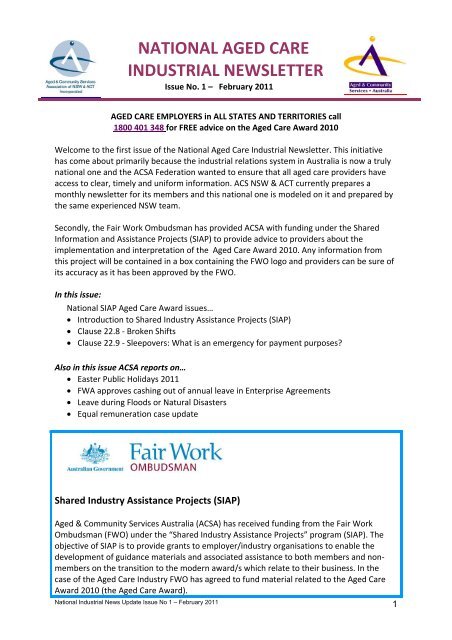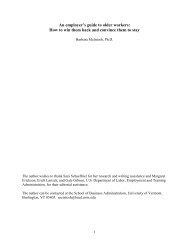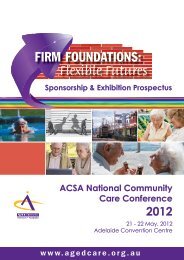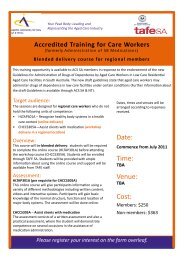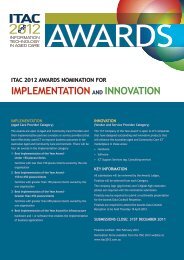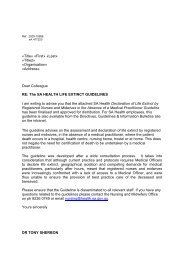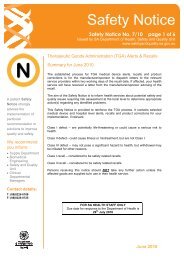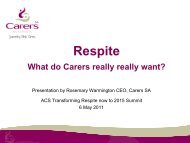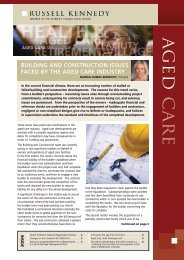national aged care industrial newsletter - Aged & Community ...
national aged care industrial newsletter - Aged & Community ...
national aged care industrial newsletter - Aged & Community ...
You also want an ePaper? Increase the reach of your titles
YUMPU automatically turns print PDFs into web optimized ePapers that Google loves.
NATIONAL AGED CARE<br />
INDUSTRIAL NEWSLETTER<br />
Issue No. 1 – February 2011<br />
AGED CARE EMPLOYERS in ALL STATES AND TERRITORIES call<br />
1800 401 348 for FREE advice on the <strong>Aged</strong> Care Award 2010<br />
Welcome to the first issue of the National <strong>Aged</strong> Care Industrial Newsletter. This initiative<br />
has come about primarily because the <strong>industrial</strong> relations system in Australia is now a truly<br />
<strong>national</strong> one and the ACSA Federation wanted to ensure that all <strong>aged</strong> <strong>care</strong> providers have<br />
access to clear, timely and uniform information. ACS NSW & ACT currently prepares a<br />
monthly <strong>newsletter</strong> for its members and this <strong>national</strong> one is modeled on it and prepared by<br />
the same experienced NSW team.<br />
Secondly, the Fair Work Ombudsman has provided ACSA with funding under the Shared<br />
Information and Assistance Projects (SIAP) to provide advice to providers about the<br />
implementation and interpretation of the <strong>Aged</strong> Care Award 2010. Any information from<br />
this project will be contained in a box containing the FWO logo and providers can be sure of<br />
its accuracy as it has been approved by the FWO.<br />
In this issue:<br />
National SIAP <strong>Aged</strong> Care Award issues…<br />
• Introduction to Shared Industry Assistance Projects (SIAP)<br />
• Clause 22.8 ‐ Broken Shifts<br />
• Clause 22.9 ‐ Sleepovers: What is an emergency for payment purposes<br />
Also in this issue ACSA reports on…<br />
• Easter Public Holidays 2011<br />
• FWA approves cashing out of annual leave in Enterprise Agreements<br />
• Leave during Floods or Natural Disasters<br />
• Equal remuneration case update<br />
Shared Industry Assistance Projects (SIAP)<br />
<strong>Aged</strong> & <strong>Community</strong> Services Australia (ACSA) has received funding from the Fair Work<br />
Ombudsman (FWO) under the “Shared Industry Assistance Projects” program (SIAP). The<br />
objective of SIAP is to provide grants to employer/industry organisations to enable the<br />
development of guidance materials and associated assistance to both members and nonmembers<br />
on the transition to the modern award/s which relate to their business. In the<br />
case of the <strong>Aged</strong> Care Industry FWO has agreed to fund material related to the <strong>Aged</strong> Care<br />
Award 2010 (the <strong>Aged</strong> Care Award).<br />
National Industrial News Update Issue No 1 – February 2011<br />
1
The Project is being undertaken by ACS NSW & ACT in conjunction with ACSA and will<br />
comprise the following elements:<br />
1. An <strong>Aged</strong> Care Award Hotline service for all <strong>Aged</strong> Care Modern Award queries (call<br />
1800 401 348). Questions involving any aspect of the Award from interpretation to<br />
transition should be directed to this number. The service will operate Monday to<br />
Friday, 9am to 5pm and be manned by the ACS Employee Relations Team. The service<br />
will be funded by the Fair Work Ombudsman and be available until the 15/04/2010<br />
free of charge to members and non‐members.<br />
2. An interpretative guide to the <strong>Aged</strong> Care Award to explain, by way of example, how<br />
to phase‐in (whether up or down) wages, loadings and penalties in accordance with<br />
the transitional provisions of the <strong>Aged</strong> Care Award.<br />
3. Classification Translation and Transition Tables for ALL States and Territories. These<br />
tables will assist <strong>Aged</strong> Care Employers across Australia to show how the employment<br />
classifications in all state and territory <strong>Aged</strong> Care NAPSAs and Pre‐Modern awards<br />
translate to the <strong>Aged</strong> Care Award and what rates are payable.<br />
4. An annotated <strong>Aged</strong> Care Award highlighting the difficult and confusing clauses and<br />
providing interpretation and explanation where appropriate.<br />
5. This monthly National Industrial Newsletter available to all <strong>Aged</strong> Care providers.<br />
Among other Industrial Relations issues of relevance to the <strong>Aged</strong> Care Industry the<br />
Newsletter will include articles specifically targeting the <strong>Aged</strong> Care Award. These<br />
articles will cover important issues of interpretation and clarification.<br />
All educational materials developed as part of the SIAP program will be available on the<br />
various ACSA Federation websites free of charge to members and non‐ members.<br />
<strong>Aged</strong> Care Employers in ALL States and Territories call 1800 401 348 for FREE advice on the<br />
<strong>Aged</strong> Care Award 2010.<br />
This month we analyse the Broken Shift and Sleepover clauses of the Award<br />
Clause 22.8 ‐ Broken Shifts.<br />
A broken shift is a single shift, worked by a casual or part‐time employee, with one or more<br />
break/s (totalling less than 4 hours), in addition to those breaks required in accordance with<br />
clause 24 for meals and tea breaks and where the span of hours is not more than 12 hours.<br />
All work performed beyond the maximum span of 12 hours for a broken shift will be paid at<br />
double time. Regardless of the number of hours an employee works within the 12 hour span<br />
of a broken shift any work beyond the 12 hour span is paid for at double time.<br />
An employee cannot be required to work a broken shift. Mutual agreement is necessary.<br />
Whilst we would recommend that the “mutual agreement” is recorded in writing it is<br />
essential where the working of a Broken Shift by a part‐time employee would require the<br />
employee to perform more hours than their normal rostered hours for that day (see clause<br />
25.1(b)(iii) and clause 10.3(c)).<br />
National Industrial News Update Issue No 1 – February 2011<br />
2
Where written agreement is reached the employee may be asked to work up to ten ordinary<br />
hours before normal overtime applies (see clause 25.1(b)(ii)). Without written agreement<br />
overtime would be payable for all additional hours worked within that shift (see clause<br />
25.1(b)(iii)).<br />
Payment for a broken shift will be at ordinary pay with penalty rates and shift allowances in<br />
accordance with clauses 25‐Overtime penalty rates and 26‐Shiftwork. As with any normal<br />
shift the shift allowances (if any) are determined by the commencing time of the broken<br />
shift, not the commencing time of each of the work periods within the broken shift.<br />
An employee must receive a minimum break of 10 hours between broken shifts rostered on<br />
successive days (see clause 22.8(e). Even though, in accordance with clause 22.4(b) it is<br />
possible in other circumstances, by mutual agreement, to reduce a 10 hour rest break to 8<br />
hours, clause 22.8(e) which specifically refers to the rest period between broken shifts does<br />
not allow for a reduction of the 10 hour break.<br />
Example 1: A broken shift, with one break, worked on a Tuesday (part‐time employee).<br />
Start Break start Break finish Finish<br />
09:00 12:00 15:00 19:00<br />
The broken shift is the period commencing 09:00 and ending at 19:00. It is a normal shift<br />
but with an extended break period in the middle.<br />
Total span (09.00 – 19.00) is 10 hours and within the 12 hour limit therefore is okay.<br />
Break (12.00 – 15.00) including a half hour meal break is 3 hours (not more than 4 hours and<br />
not including a meal break) and is therefore okay.<br />
Any shift payments are determined by the starting time of the shift. In this example the shift<br />
commences at 09:00 and in accordance with clause 26, no shift penalties apply to a shift<br />
commencing at that time.<br />
The total working time is 7 ordinary hours (less than 10 hours) therefore no overtime is<br />
payable.<br />
NB: In this example the employee was asked to work additional hours beyond their normal<br />
rostered hours on that day therefore the mutual agreement to work the broken shift was<br />
recorded in writing. Since the agreement was recorded in writing no overtime is payable for<br />
the additional hours. The working of the additional hours did not take the employee above<br />
38 hours (where employed weekly) or 76 hours (where employed fortnightly).<br />
Example 2: A broken shift, with 2 breaks, worked on a Wednesday (part‐time employee).<br />
Start Break start Break finish Break start Break finish Finish<br />
07:00 10:00 11:30 14:30 16:00 19:30<br />
National Industrial News Update Issue No 1 – February 2011<br />
3
Entitlements<br />
The broken shift is the period starting at 07:00 and ending at 19:30. This employee<br />
Therefore worked a half an hour beyond the 12 hour span. This half an hour must be paid at<br />
double time.<br />
Breaks (10.00 – 11.30) and (14.30 – 16.00) including meal breaks total 3.5 hours and is okay.<br />
Commencement time of the broken shift is 07:00 and therefore in accordance with Clause<br />
26 no shift penalties apply.<br />
If by working the broken shift the employee is asked to work beyond their normal rostered<br />
hours for the day AND written agreement is reached in accordance with Clause 10.3(c) the<br />
employee would be paid at ordinary time up to 10 hours and overtime after 10 hours.<br />
The total working time is 11.5 hours (more than 10 hours) therefore the following overtime<br />
would be payable:<br />
• 0.5 hours at double time (19.00 – 19.30) as this time is outside the 12 hour span; and<br />
• 1 hour worked is paid at time and a half (18.00 – 19.00) as this time is beyond 10 hour<br />
maximum that ordinary hours may be worked (see clause 25.1(b)(ii) ‐ overtime).<br />
• If by working the additional hours up to 10 on the day, the employee exceeds 38 hours<br />
(where employed weekly) or 76 hours (where employed fortnightly) overtime would<br />
be payable for work beyond those hours (see clause 25(b)(i)).<br />
NB: If in the above example the mutual agreement was not recorded in writing, overtime<br />
would be payable for hours worked beyond the employee’s normal hours for that day.<br />
Clause 22.9 ‐ Sleepovers<br />
• What is an emergency for the purposes of payment<br />
A sleepover means sleeping in at night in order to be on call for emergencies. No work other<br />
than that of an emergency nature will be required to be performed during any sleepover. An<br />
emergency is any unplanned occurrence or event requiring prompt action.<br />
To date the meaning of “Emergency” for the purposes of payment within this clause has not<br />
been tested by FWA; however the following represents an example of industry custom and<br />
practice.<br />
An event requiring prompt action may initially be unplanned and unanticipated particularly<br />
if it has never previously occurred. If, however, the event became regular and anticipated,<br />
although still requiring prompt action, it may not constitute an emergency, for the purposes<br />
of payment under this clause.<br />
National Industrial News Update Issue No 1 – February 2011<br />
4
An example of such a situation might involve a resident found to be disoriented and<br />
wandering for the first time late at night. The event has never previously happened and no<br />
history in the resident’s <strong>care</strong> plan, therefore an employee responding to help the resident<br />
would be paid as an emergency.<br />
If the behaviour of the resident over time became regular, anticipated and perhaps written<br />
into the resident’s <strong>care</strong> plan an employee assisting the resident would be entitled to be paid<br />
as a non‐emergency even though the event requires prompt action.<br />
Payment<br />
• An employee performing a sleepover is entitled to a sleepover allowance of 5.2% of<br />
the standard rate for each night on which they sleepover (see clause 22.9(d)).<br />
• An employee who performs emergency work during a sleepover is entitled to<br />
payment for the exact period of the work (see clause 22.9(g)).<br />
• An employee who performs work other than that of an emergency nature during any<br />
sleepover will be paid the appropriate hourly rate from the start of the sleepover to<br />
the end of the non‐emergency work, or from the start of the non‐emergency work to<br />
the end of the sleepover, whichever is the lesser, in addition to the sleepover<br />
allowance (see clause 22.9(f)).<br />
• Shift, weekend and overtime penalties are payable, where applicable, for work<br />
performed during a sleepover (see clause 22.9(g)).<br />
NB: A sleepover may be rostered to commence immediately at the conclusion of the<br />
employee’s shift and continuous with that shift; and/or immediately prior to the employee’s<br />
shift and continuous with that shift, and not otherwise.<br />
Example<br />
A Part‐time employee works a sleepover on Tuesday from 23:00 to 08:00. During the<br />
sleepover the employee is called to work from 03:00 to 03:30. What payment is applicable<br />
Where the work is an emergency the employee is entitled to payment for 30 minutes work<br />
(3:00 to 03.30) at the 15% shift loading in accordance with clause 22.9(g)(ii).<br />
Where the work is non‐emergency in nature the employee is entitled to be paid at the 15%<br />
shift loading in accordance with clause 22.9(g)(ii) from 23:00 to 03:30 in accordance with<br />
clause 22.9(f) as this period is less than the period 3am to 8am.<br />
ACSA News Report<br />
National Industrial News Update Issue No 1 – February 2011<br />
5
EASTER PUBLIC HOLIDAYS 2011<br />
Each State and Territory has taken a different approach to Easter Monday/Anzac Day this<br />
year, either by substituting a day or declaring an additional day. Adding to the confusion,<br />
not all states have declared the same holidays for Easter with between 3 and 5 declared<br />
public holidays over the period.<br />
In all States and Territories 22, 25 and 26 April are declared holidays. In some States, either<br />
or both 23 and 24 April may also be declared holidays.<br />
The Public Holidays for Easter/ANZAC Day are listed below:<br />
New South Wales – 5 days<br />
Friday, 22 April 2011 (Good Friday)<br />
Saturday, 23 April 2011 (Easter Saturday)<br />
Sunday, 24 April 2011 (Easter Sunday)<br />
Monday, 25 April 2011 (ANZAC Day)<br />
Tuesday, 26 April 2011 (Easter Monday) [substitute for Easter Monday]<br />
NSW: www.<strong>industrial</strong>relations.nsw.gov.au/About_NSW_IR/Public_Holidays.html<br />
Australian Capital Territory – 4 days<br />
Friday, 22 April 2011 (Good Friday)<br />
Saturday, 23 April 2011 (Easter Saturday)<br />
Monday, 25 April 2011 (Easter Monday)<br />
Monday, 25 April 2011 (ANZAC DAY)<br />
Tuesday, 26 April 2011 [In recognition of the congruence of Anzac Day and Easter Monday]<br />
ACT:www.cmd.act.gov.au/__data/assets/pdf_file/0019/119323/publicholidays2011.pdf<br />
Victoria – 4 days<br />
Friday, 22 April 2011 (Good Friday)<br />
Saturday, 23 April 2011 (Easter Saturday)<br />
Monday, 25 April 2011 (Easter Monday)<br />
Tuesday, 26 April 2011 (ANZAC Day ‐ substitute for Monday 25 April)<br />
VIC: www.vic.gov.au/Victorian‐Public‐Holiday‐Dates.html<br />
Queensland – 4 days<br />
Friday, 22 April 2011 (Good Friday)<br />
Saturday, 23 April 2011 (Easter Saturday)<br />
Monday, 25 April 2011 (ANZAC DAY)<br />
Tuesday, 26 April 2011 (Easter Monday)<br />
QLD:www.justice.qld.gov.au/fair‐and‐safe‐work/<strong>industrial</strong>‐relations/public‐holidays/publicholiday‐dates‐for‐2008‐2013<br />
South Australia – 4 days<br />
Friday, 22 April 2011 (Good Friday)<br />
Saturday, 23 April 2011 (Easter Saturday)<br />
Monday, 25 April 2011 (ANZAC DAY & Easter Monday)<br />
Tuesday, 26 April 2011 (Easter Tuesday)<br />
SA: www.safework.sa.gov.au/show_page.jspid=2483<br />
National Industrial News Update Issue No 1 – February 2011<br />
6
Western Australia – 3 days<br />
Friday, 22 April 2011 (Good Friday)<br />
Monday, 25 April 2011 (ANZAC DAY)<br />
Tuesday, 26 April 2011 (Easter Monday)<br />
WA:www.commerce.wa.gov.au/LabourRelations/Content/Employers/Pay_rates_leave_and<br />
_conditions/Public_holidays_in_Western_Aus.html<br />
Tasmania – 3 days<br />
Friday, 22 April 2011 (Good Friday)<br />
Monday, 25 April 2011 (ANZAC DAY & Easter Monday)<br />
Tuesday, 26 April 2011 (Easter Tuesday*)<br />
*Restricted public holiday currently observed by certain awards/agreements and the State<br />
Public Service<br />
TAS: www.wst.tas.gov.au/__data/assets/pdf_file/0006/157974/GB067.pdf<br />
Northern Territory – 4 days<br />
Friday, 22 April 2011 (Good Friday)<br />
Saturday, 23 April 2011 (Easter Saturday)<br />
Monday, 25 April 2011 (ANZAC DAY & Easter Monday)<br />
Tuesday, 26 April 2011 (Additional Public Holiday)<br />
NT: www.ocpe.nt.gov.au/legislation/holidays<br />
Public Holiday Entitlements<br />
The National Employment Standards (NES) entitle employees to take declared public<br />
holidays and to be paid their base rate for the ordinary hours they would have worked on<br />
the day. The NES also entitle employees to reasonably refuse to work on a public holiday.<br />
In relation to payments on a public holiday worked, notwithstanding that the NES may<br />
recognise a day as a public holiday, there is no statutory obligation under the Fair Work Act<br />
(“the Act”) that requires an employer to pay a penalty rate. Any applicable penalty rate will<br />
be derived from the relevant <strong>industrial</strong> instrument (the relevant modern award or<br />
agreement, or the employee’s contract of employment).<br />
Where an employee is covered by a modern award, the transitional penalty rate should be<br />
applied. The transitional arrangements under a modern award will apply where there is a<br />
difference (higher or lower) between the public holiday penalty rate under the previous prereform<br />
federal award or NAPSA and the relevant modern award.<br />
Substitute Holidays<br />
Clause 32.2 of the Nurses Award, allows the employer and majority of employees to agree<br />
to substitute another day for a public holiday. This means that the substitute day is the<br />
public holiday for both the NES and the award’s penalties.<br />
There is no equivalent provision to substitute a public holiday in the <strong>Aged</strong> Care Award or the<br />
Social, <strong>Community</strong>, Home Care and Disability Services Award.<br />
National Industrial News Update Issue No 1 – February 2011<br />
7
NB 1. Holidays may be subject to change by proclamation or gazettal by State or Territory<br />
governments.<br />
NB 2. Local Public Holidays are recognised by the Act as public holidays for the purposes of<br />
the National Employment Standard (NES) and therefore become a statutory entitlement.<br />
(Source: WorkplaceInfo)<br />
FWA approves cashing out of annual leave in Enterprise Agreements<br />
The rejection of three enterprise agreements by Fair Work Australia Commissioner Ryan on<br />
the grounds that they included a clause allowing for the cashing out of annual leave has<br />
been overturned by the Full Bench on appeal.<br />
Section 93 of the Fair Work Act 2009 allows the cashing out of annual leave provided an<br />
employee retains at least four weeks of annual leave and the enterprise agreement covering<br />
the employee has a clause which allows cashing out.<br />
At paragraph 68 of the Armacell Australia decision Commissioner Ryan concluded that while<br />
the clauses in the agreement satisfied the Fair Work Act, employees were disadvant<strong>aged</strong> in<br />
that they could conceivably work for the life of the agreement without taking a real and<br />
effective break from work.<br />
In overturning Commissioner Ryan’s decision, the Full Bench made the following<br />
observations:<br />
1. The terms of the cashing out provision in s.93(2) are in the nature of protections for<br />
employees and could be described as safeguards.<br />
2. Accordingly, as a matter of interpretation, the legislature considered the safeguards<br />
specified in s.93(2) to be sufficient. It would be inconsistent to now hold that the<br />
safeguards are inadequate and that more or other safeguards should be applied.<br />
3. The Commissioner was concerned with situations in which employees might not take<br />
annual leave and the purpose of annual leave might be frustrated…valid concerns but<br />
beside the point.<br />
4. The BOOT test, as the name implies, requires an overall assessment to be made. The<br />
approach adopted by the Commissioner identifies a term (on his view anyway) less<br />
beneficial for an employee. There is nothing on the face of the Commissioner’s decision<br />
to indicate what account, if any, he took of any terms which might be more beneficial<br />
for an employee.<br />
Read the Full Bench Decision: [2010] FWAFB 9985 (24 December 2010)<br />
Leave during Floods or Natural Disasters<br />
The widespread and tragic recent floods have prompted the question about employee leave<br />
entitlements during periods of floods or other natural disasters.<br />
Leave for non‐attendance due to floods or natural disasters<br />
Whilst some awards or agreements contain provisions about leave for non‐attendance due<br />
National Industrial News Update Issue No 1 – February 2011<br />
8
to floods or other natural disasters, the <strong>Aged</strong> Care Award 2010, Nurses Award 2010 and the<br />
SCHCDSI Award do not.<br />
As there is no specific leave entitlement for an employee unable to attend work due to<br />
floods or other natural disasters under the Fair Work Act 2009 the question of the approval<br />
(or otherwise) of paid or unpaid leave is purely at the discretion of the employer.<br />
Carer’s leave if schools close due to the floods<br />
Employees who have an entitlement to paid personal leave under the National Employment<br />
Standards (NES) in the Fair Work Act 2009 are entitled to take <strong>care</strong>r’s leave to provide <strong>care</strong><br />
or support to a member of their immediate family, or a member of their household, who<br />
requires <strong>care</strong> or support because of an unexpected emergency. This includes a natural<br />
disaster.<br />
Employees who have exhausted their paid personal leave entitlement, and casual<br />
employees, are eligible for up to 2 days unpaid <strong>care</strong>r’s leave per occasion in the event of an<br />
unexpected emergency.<br />
An employer may require an employee to provide evidence in support of the leave period.<br />
Employer shut downs as a result of floods or natural disasters<br />
Section 524 of the Fair Work Act 2009 includes provisions which enable employers to stand<br />
down employees, without pay, where they cannot usefully be employed during a period<br />
because of any stoppage of work for which the employer cannot reasonably be held<br />
responsible, such as a natural disaster.<br />
Emergency Services Leave to assist with flood‐relief operations<br />
Emergency services leave is part of the entitlement to ‘community services leave’ from the<br />
NES. The relevant sections of the Fair Work Act 2009 are ss108–112.<br />
A full‐time or part‐time employee (who is a member of a recognised emergency<br />
management body) is entitled to take a period of unpaid leave to attend an ‘eligible<br />
community service activity’, which includes a ‘voluntary emergency service activity’. The Act<br />
does not specify any minimum or maximum time limits for an emergency service activity. An<br />
employer is entitled to set a maximum period of absence, and is also entitled to make a<br />
request to the emergency service organisation that the employee be released from<br />
emergency duties if business performance is being disrupted, but cannot insist.<br />
An employee who wishes to take a period of community service leave must comply with the<br />
notice and evidentiary requirements in addition to meeting the criteria found under the<br />
relevant sections of the Act.<br />
There is no legal obligation under the NES to pay the employee for any absence on<br />
emergency service leave. However, the employee’s period of service continues unbroken<br />
during the period of leave, so other entitlements continue to accrue during the period of<br />
leave, such as entitlements to other forms of leave.<br />
National Industrial News Update Issue No 1 – February 2011<br />
9
Emergency Services:<br />
For more information on what to do in the event of floods or other natural disasters please<br />
visit:<br />
• Australian Government:<br />
Australian Government Disaster Assist<br />
• Queensland Government:<br />
Disaster relief and recovery<br />
• NSW Government:<br />
Emergency Management NSW<br />
• South Australian Government:<br />
Department for Families and Communities Disaster Recovery<br />
• Victorian Government:<br />
Department of Human Services Emergency Management<br />
• Western Australian Government:<br />
Fire & Emergency Services Authority of Western Australia<br />
• ACT Government:<br />
ACT Emergency Services Agency<br />
• NT Government:<br />
Northern Territory Emergency Service<br />
Equal Remuneration Case Update<br />
Australia’s largest <strong>industrial</strong> hearing continues with at least 20 lawyers facing off before the<br />
full bench of FWA in the most important pay equity case for four decades. The landmark<br />
case concerns the ASU’s push for an equal pay order in the social and community services<br />
sector.<br />
The nationwide case before Fair Work Australia is seeking large pay rises for tens of<br />
thousands of workers and is based on a 2009 Queensland decision, which awarded pay rises<br />
of up to 37 per cent over three years.<br />
Unions argue that workers in the female‐dominated sector have suffered from their work<br />
historically being regarded as ''women's work.” If the union case is successful, much of the<br />
burden would fall on State governments, which fund many of the programs undertaken in<br />
the sector.<br />
The Age recently reported that the equal pay case could cost between $700 million and $1.7<br />
billion over four years in Victoria alone. Such an estimate however fails to consider the<br />
significant flow‐on consequences to other areas of the labour market, including Home Care.<br />
Members interested in the latest developments can access FWA’s dedicated website<br />
containing transcripts of the day’s hearings and copies of all submissions filed:<br />
http://www.fwa.gov.au/index.cfmpagename=remuneration&page=introduction<br />
(Source: The Age)<br />
National Industrial News Update Issue No 1 – February 2011<br />
10


